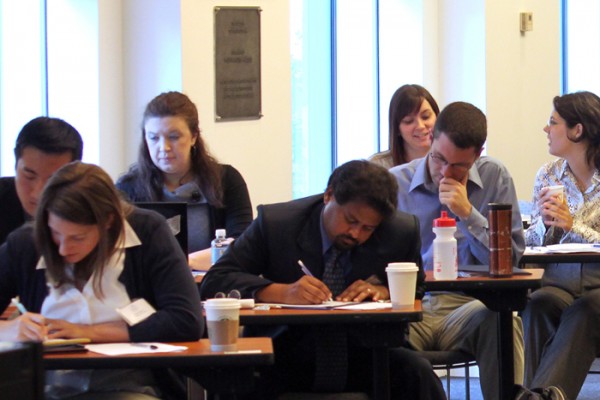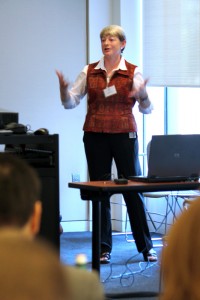15 June 2012
From TV studio to Congressional office, choose brief and simple to convey science and its uncertainty
Posted by mcadams

Professional scientists and PhD students work on a message-crafting exercise at the AGU science communications training, part of the American Meteorological Society's Summer Policy Colloquium, on June 7th. Photo by AGU.
At a June 7 science communications training hosted by the American Geophysical Union in Washington, D.C., a local TV weather man and a Capitol Hill insider led off the event with insights on how best to communicate with two important audiences: the public and Congress. AGU offered the training, for the second consecutive year, as part of a 10–day colloquium on policy and communication conducted each summer by the American Meteorological Society.
Dan Satterfield deals with uncertainty every day as Chief Meteorologist for WBOC-TV in Salisbury, Maryland. Now in his 32nd year of on-air television reporting, he said that a large part of his job is knowing how best to communicate about that tricky topic.
For scientists wary of communicating their scientific research to the public for fear of being misunderstood or over- technical, Satterfield had this advice “Don’t worry about getting it perfect.” Weather, like all scientific research, is riddled with probabilities and uncertainty, and communicating a study’s uncertainty is difficult, but there are tricks of the trade to help scientists through.
“Tell them what you know and not what you don’t know,” he urged. Avoid phrases that imply doubt like “we think” and “it could be” and replace them with equally accurate but more definitive statements such as “this is the best science we have” and “it most likely is this.”

Dan Satterfield, Chief Meteorologist for WBOC-TV (Salisbury, Md.) advises scientist-communicators to “Tell them what you know and not what you don’t know." Photo by AGU.
And don’t forget, he added, whenever you’re explaining science to the public, “humor works.” To illustrate this, Satterfield played a clip from Comedy Central’s The Colbert Report in which Steven Colbert plays complex measurements and graphs against humorous quips about the metric system and photos of wooly mammoths in Escalades. Satterfield is also a blogger –at Dan’s Wild Wild Science Journal – which appears on an AGU-hosted blogging site: the AGU Blogosphere.
For weather reporters like Satterfield, another major constraint is time – he’s got only minutes to get across the information he wants to convey. That’s also true for any scientist who manages to catch the ear of a politician, panel speaker Maeve Boland told the colloquium audience.
Boland is a PhD geologist and was AGU’s 2009-10 Congressional Science Fellow (an AAAS program), serving for a year as a science adviser on U.S. Senator Byron Dorgan’s staff.
Brevity is a key consideration, she said, because scientists who get an audience with a Congress member or someone on his or her staff have only a short window of opportunity to communicate the importance of their research. When that window opens, Boland added, keep in mind that members of Congress, like the general public, are more often concerned with the impact of scientific research than the research itself.
There are three critical questions to ask yourself when determining what Congress person to talk to and what to communicate, Boland said:

Maeve Boland, who spent a year in U.S. Senator Byron Dorgan's office as AGU's 2009-10 Congressional Science Fellow, tells the scientists to keep their messages simple and direct when speaking to law-makers. Photo by AGU.
- Does the member of Congress I’m thinking of contacting represent me, and is he/she on a committee that works on legislation I care about?
- What is my message?
- What action do I want the Congressional member to take?
She also shared three main tips on how to communicate with a Congress member:
- Find which member of Congress supports the policy that relates best to the issues your research may help improve.
- Approach members of Congress early in their term because it will take time for any policy or action to pass.
- Refine your message so that it is as succinct, simple, and direct as possible.
During a question-and-answer session that followed the panelists’ talks, one message came through loud and clear in their responses: scientists should be as open with their research as possible. In order to gain trust and respect from an audience, scientists must be transparent with both their methods and results so that the audience trusts in the accuracy of the science and the capability of the scientist.
–Jessica Orwig, AGU Public Information Intern


 The Plainspoken Scientist is the science communication blog of AGU’s Sharing Science program. With this blog, we wish to showcase creative and effective science communication via multiple mediums and modes.
The Plainspoken Scientist is the science communication blog of AGU’s Sharing Science program. With this blog, we wish to showcase creative and effective science communication via multiple mediums and modes.